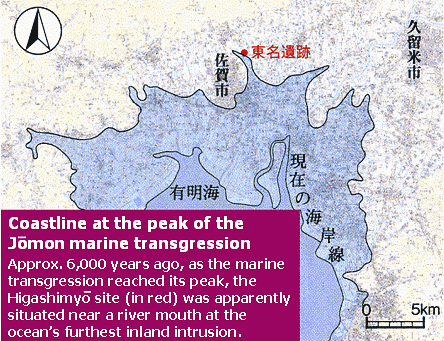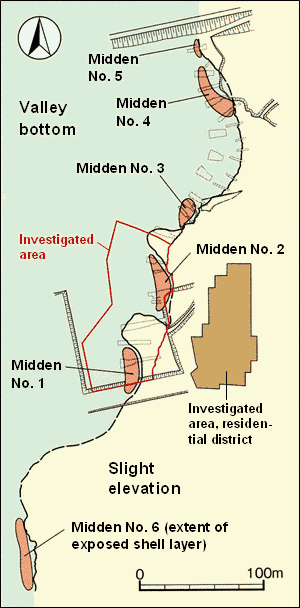Higashimyō:
A group of large-scale shell middens from the Earliest Jōmon. The oldest woven baskets in the country are found in large numbers. Wooden implements and tools of bone and antler give evidence of pioneering craftsmanship.
Higashimyō Site, Saga City, Saga Prefecture
Higashimyō is a site from the end of the Earliest Jōmon period (7,000 years ago), located approximately 4 km north of the central portion of the city of Saga. From investigations to date, it is known to be comprised of a residential district atop a slight rise less than 3 m in elevation, plus shell middens accompanied by acorn storage pits made in the valley bottom at an elevation of 0 m or less.

Adapted from Hakkutsu sareta Nihon rettō 2007 [Excavations in the Japanese Archipelago, 2007] (Bunkachō [Agency for Cultural Affairs], ed., Asahi Shimbunsha, 2007).
|
A site submerged by the Jōmon marine transgression
At the time, the sea level was rising throughout the Japanese archipelago due to climatic warming, apparently reaching a peak at approximately six thousand years ago. The site was submerged in its entirely at that point, and rapidly covered with a layer of clay. For this reason animal and plant remains have survived in good condition, and the Higashimyō site is an extremely valuable source of information for obtaining a clear image, centering on dietary habits, of the daily life and culture of the period.
Woven baskets filled with acorns
Of the six shell middens that have been discovered approximately 5 m below the present ground surface, Nos. 1 and 2 have been excavated. The shell strata survive at thicknesses of up to 1.4 m, and as they are mainly composed of only four species – brackish-water clams (Corbicula japonica), razor clams, cockles, and oysters – it is possible these were deliberately selected.
Also, within the shell strata and in the surrounding vicinity, over 130 acorn storage pits and other pits possibly used as such have been identified. From more than half of these the oldest woven baskets in the country have been recovered, but as all of these items are damaged, it is thought that baskets used in the transport or storage of acorns were left, when broken, in the storage pits. They provide valuable information for considerations of how storage pits were used.
The majority of the baskets are plaited using strips of split wood, but there is a rich variety of basket weaving including items of mesh with hexagonal eyes, and twined items made with vines.
In addition, there are dishes provided with handles and vase-shaped wooden containers, wooden combs, and bone and antler artifacts beginning with bodily ornaments made of antler and bearing geometric designs, providing evidence that a high level of craftsmanship goes back to the Earliest phase of the Jōmon period. (Nishida Iwao)






